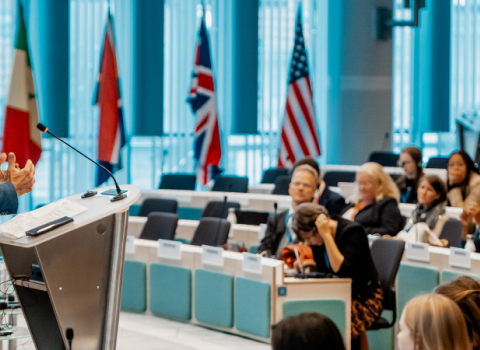Since March 2020 the European Commission has been making moves to improve Europe’s industrial competitiveness. Experts say things are moving in the right direction, but warn there is not enough money or enough focus on scaling up

European Commission President Ursula von der Leyen. Photo: Dati Bendo / European Union
EU attempts to increase its manufacturing output date back to 2014, but it was in March 2020 that the first industrial strategy was unveiled – one day before the World Health Organisation decreed COVID-19 was a global pandemic.
The subsequent exposure of shortcomings in Europe’s supply chains and its dependence on imports of critical raw materials and products led to the industrial strategy being updated. But it was the US Inflation Reduction Act, including tax breaks worth $369 billion for electric cars and other clean technologies that really focused minds, leading to the announcement in February of the Green Deal Industrial plan, which aims “to enhance the competitiveness of Europe’s net-zero industry and support the fast transition to climate neutrality”.
“The plan builds on previous initiatives and relies on the strengths of the EU Single Market, complementing ongoing efforts under the European Green Deal and REPowerEU,” the Commission said when it was published.
Several parts are included in the plan, including the Net-Zero Industry Act, the Critical Raw Materials Act, and a reform of the electricity market design. The Commission also presented as a part of this a new framework for state aid, while also aiming to streamline and simplify the approval of Important Projects of Common European Interest.
Malte Lohan, director general of Orgalim, a lobby group representing Europe's technology industries, questions the Commission’s targeted approach. At one level, “This is fine because there are places in the economy where targeted intervention can work.” But he said, “We think there should be more because not all feel supported by this approach.” Europe should also seriously think about lifting industry across the board.
The EU needs a better framework to maintain investment and financing for industry, but currently, the situation is deteriorating, Lohan said. “Adjusted for inflation, European industry is shrinking. The picture is far from rosy.”
The European Round Table for Industry (ERT) agrees. Its latest CEO confidence survey shows members are increasingly worried about Europe’s competitiveness. This needs to be addressed through investment in innovation, said Robert O’Meara, ERT spokesman. The main risks, according to ERT members, are geopolitics, inflation and the cost of energy.
“Europe is the oldest industrialised region in the world, and it is also the region with the most intensive regulatory environment in the world,” Meara said. “In a global context, we have to renew our industrial base to make it work with the new strategy of digital and green transition.”
In March, ERT launched a ‘flagship on innovation’ in which it underlines that if Europe wants to reclaim its competitiveness, it has to restore the business case for innovation.” The trade body makes three recommendations for doing this: rethink regulation; re-focus on robust intellectual property rights and international standardisation; and scale-up investment in innovation.
Where is the money?
That is certainly one objective of the Green Industrial Plan, in which the Commission says it wants to “speed up investment and financing for clean tech production in Europe”.
The means for doing that was supposed to be a European sovereignty fund. But this has now been downgraded to the Strategic Technologies European Platform (STEP), through which €10 billion will be added to existing programmes.
Announcing STEP last month, Commission President Ursula von der Leyen said it would “set the stage” to mobilise funding across various EU programmes, to reach up to €160 billion in investments “in the coming years”, as the “precursor to a fully-fledged Sovereignty Fund that would be created in the future.”
Philipp Lausberg, policy analyst at the European Policy Centre (EPC) and Milan Elkerbout, policy researcher at the Centre for European Policy Studies (CEPS) both agree the sovereignty fund was a step too far in the current environment, since it required approval from all member state government.
Of the €10 billion STEP fund, €3 billion is going to InvestEU, €500 million to Horizon Europe, €5 billion to the Innovation Fund, and €1.5 billion to the European Defence Fund.
The Commission said the effect of this investment will be bolstered by a new structure that will be set up to direct existing funding towards STEP projects and speed up implementation in areas which have been identified as crucial for Europe's leadership.
This proposal has to be approved by the European Parliament and the European Council, with the Commission calling on the Spanish Presidency of the Council to reach an agreement after the summer and for the changes to be in place for 2024.
For Lausberg, the downgrade from a sovereign fund to an add-on to existing programmes is “a disappointment”. It is “much less than initially promised” and “basically is a reshuffling of money,” he said. The €10 billion STEP fund, “is not enough to really solve the problems we are facing.”
There are two areas where the sovereignty fund would really have made a difference. First, it would have provided a counterbalance to the use of state aid. Second, it could have provided money for innovation, and more specifically for scaling up industries.
Following the pandemic the rules on state aid were liberalised. But Lausberg said, the use of state aid alone as a financing mechanism is not sustainable on the long term, because it means the bigger countries with the deepest pockets, like France and Germany, will be able to attract more companies. This could endanger the single market.
The use of state aid “is a sign of the times”, said Lohan. Now the tap has been opened, it will be hard to shut. “We are very nervous that it should get out of control,” he said. “We are in a subsidy race with China and the US, but also within the EU. And this last part is counterproductive.”
Private investment is essential, which for Lohan poses the question: “How can we best leverage public funds to incentivise private funding?”
One way is to foster a more investment-friendly environment for private companies. However, the culture of investment is currently overshadowed by regulation, O’Meara noted.
From innovation to market
Europe is a front runner in the quality of its science and innovation, but there is a problem with turning this into great ideas and sustainable large scale companies. “Transversal industries such as digital, green tech or quantum tend to be winner takes it all markets, and there you need the have built really big players”, Lausberg said.
Solar panels are a case in point. The technology was invented in Germany and Europe was leading until China flooded the market with its own cheaper products, leading to the collapse of the industry in Europe.
Another example is the US air conditioner manufacturer Carrier Global Corporation buying the German firm Viessmann Group's business unit that makes heat pumps for €12 billion. The buyout will position Carrier Global as a critical leader in Europe's energy transition, the company said when the deal was announced in April.
Small level of support
Programmes such as InvestEU and the Innovation fund can only provide a maximum of €50 million, far from what companies need to accelerate their growth. At the same time, the bureaucratic burden of applying for funds wears companies down and the success rate is not great. Companies that have to jump through a whole series of hoops to only get 50% of the necessary funding, are likely to conclude it is not worth the time or effort.
However Lausberg said this is one area in which the Important Projects of Common European Interest are helping, by permitting member states to jointly fund projects where the risks are too high for private investors to support breakthrough innovation.





 A unique international forum for public research organisations and companies to connect their external engagement with strategic interests around their R&D system.
A unique international forum for public research organisations and companies to connect their external engagement with strategic interests around their R&D system.